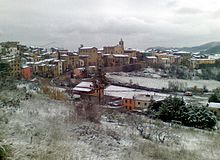Casacalenda
| Casacalenda | ||
|---|---|---|

|
|
|
| Country | Italy | |
| region | Molise | |
| province | Campobasso (CB) | |
| Coordinates | 41 ° 44 ' N , 14 ° 51' E | |
| height | 643 m slm | |
| surface | 67 km² | |
| Residents | 1,988 (Dec. 31, 2019) | |
| Population density | 30 inhabitants / km² | |
| Post Code | 86043 | |
| prefix | 0874 | |
| ISTAT number | 070011 | |
| Popular name | Casacalendesi | |
| Patron saint | Sant'Onofrio (April 7th) | |
| Website | http://casacalendacomune.it/ | |
Casacalenda is an Italian commune in the Molise region in the Campobasso province with 1988 inhabitants (as of December 31, 2019).
history
Casacalenda was founded in the 5th century BC. The town gained importance during the Second Punic War. In ancient times it was called KELENE. Although this city was important in Roman times, little is known of its later history, except for a few documents pertaining to its liege lords. From King Wilhelm II's list of barons, we can see that the castle was owned by Giuliano di Castropignano in 1175. Later the castle was owned by Giordano Siracusa (Siracusa family ) "Jordanus de Siracusa miles tenet castra Casakalendae & Sancti Martini in terra laboris". His widow Matthea de Casalchilenda sold the castle to Riccardo Caracciolo from Capua in 1324. Later the castle passed to the Dukes di Sangro .
After Italy entered the war in June 1940, the fascist regime established an internment camp ( campo di concentramento ) for women in Casacalenda . It was located in the center of the village and consisted of three large and nine small rooms spread over two floors. In addition to English women , Polish and German Jews and Yugoslav women from the areas occupied and annexed by Italy, there were also a few Jewish women from Italy in the camp. The camp was closed on September 8, 1943.
Individual evidence
- ↑ Statistiche demografiche ISTAT. Monthly population statistics of the Istituto Nazionale di Statistica , as of December 31 of 2019.
- ↑ Klaus Voigt, Refuge on Revocation. Exile in Italy 1933-1945 (Volume 2), Stuttgart 1993 (Klett-Cotta), pp. 61-63; Carlo Spartaco Capogreco, I campi del duce. L'internamento civile nell'Italia fascista (1940-1943) , Torino 2004 (Einaudi), p. 207


